
Minenoura
Walking Through Minenoura
Yamadera is one of the most popular sites to visit in
Yamagata Prefecture.
However, many people just visit the main temple hall,
the konpon-chūdō,
and nearby monuments just above the river.
Make sure to also visit Minenoura,
a nearby area where Buddhist monks and
Shugendō mountain ascetics
meditated and trained for over a thousand years.
A trail leads through the forest,
starting close to the main Risshaku-ji temple hall
and ending at the Senjuin Kannon-dō temple.
From there you can return along the road,
or you could reverse your path along the trail.
Yamadera has a small Tourist Information office along the main road through town. Arrive by train, cross the river, and walk toward the konpon-chūdō, the main temple hall. You will pass the Tourist Information on your right. They may have a useful map.
Below is a picture of a map I found near the end of the trail. It shows the points I passed. They're shown and described below:
- Yamadera cemetery.
- The old approach leads up through the forest.
- The ancient Honin temple site.
- Caves with gorintō grave memorial markers.
- Shugendō training grounds.
- Shiro-iwa Nana-iwa, a series of seven rock outcroppings, several of which have fantastic views over the valley to surrounding mountains.
- The Tarumizu shrine complex.
- Down the slope labeled Tarumizu Approach.
- Senjuin Kannon-dō, a Buddhist temple that's one of a pilgrimage series of 33 significant temples.
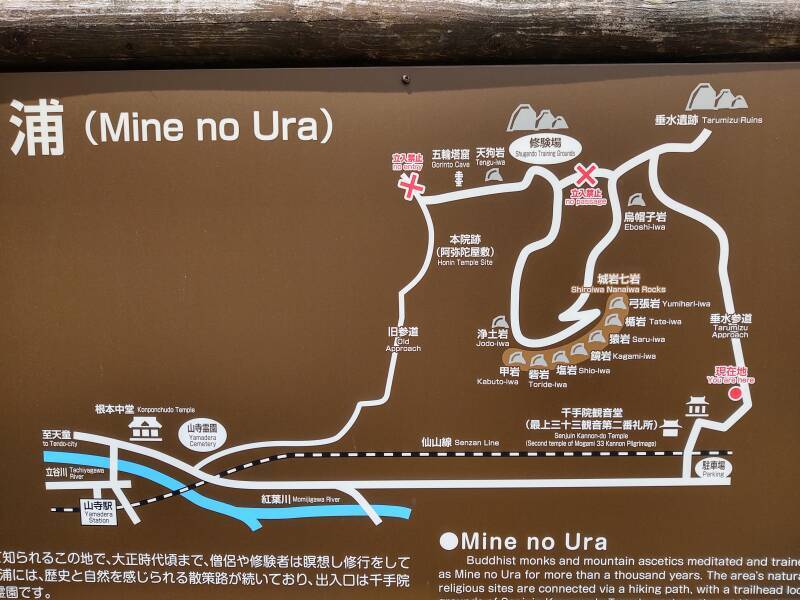
Yamadera Cemetery
I had already visited the Risshaku-ji temple complex, climbing the 1,000 stone steps up the mountain face. Now I had returned for a second day in Yamadera, taking the train from near where I was staying in Yamagata.
I crossed the bridge and passed the konpon-chūdō, the main temple hall of the Risshaku-ji temple complex. The town's cemetery is a short distance beyond that.





Walk through the cemetery. At the far end, turn downhill to the right, pass through the gate, and you're on the path.

You soon pass a shed used for trail maintenance work. A poster warns you to watch out for bears. There's more on the woodland creatures at the other end of the trail.


A sign near the beginning of the path says, according to Google Translate for Images:
Gozu-tenno Monument / Shinbo-nyoten Monument
This is the entrance to the Minenoura sacred area
and main temple ruins.
Two stone monuments stand on the mountainside.
One is for Gozu-tenno,
a demon from hell with the head of a cow.
It was the custom from ancient times to
offer cucumbers and pray for a rich harvest at the
Gozu-tenno monument.
The other is for Bo-nyoten, or
Divine Mother Nyoten,
also known as Senju Kannon.
The subject of the second, Bo-Nyoten or Senju Kannon, is the figure of devotion at Senju-in Kannon-dō, the temple at the other end of the trail.
The path leads uphill through the forest.

Prehistoric Jōmon Settlement and 14th Century Honin Temple Site
The clearing at 38.315988° N, 140.441433° E once held a major temple honoring Amitābha, known in Japanese as Amida Nyorai, the Buddha of Infinite Light.


The signboard has a map of the site. The red circle is the viewpoint of the above picture, looking roughly north from the sign, and brown areas are ruins of structures.
The largest structure is the Amida temple.
The two thin structures immediately to its northwest are the Yakushido ruins.
Beyond those are two structures labeled Iwayamae.
The Shizanji Cemetery is to the south of the viewpoint.

The sign has some pictures and explanations, entirely in Japanese as we should expect. I have only found a little information online.

A separate panel says, according to Google Translate for images and several corrections:
Mine-no-Ura Honin Temple has names such as Honin Temple (Amida Residence Ruins), Yakushido Ruins, Sokuenji Temple Ruins, and Gorin Tokutsu. In addition, there are Tengu Rock, Oni Rock, Lotus Pond Ruins, Dabiba Ruins, etc. There is also a legend that "a golden chicken and a lacquer barrel are buried here". This area was a farmland until around the latter half of 1955, and people were forbidden to use human or livestock excrement as fertilizer.
For three years starting in 2010, in order to verify these traditions, we formed the "Yamadera Minenoura District Cultural Properties Preservation Society," and carried out excavations entirely on a volunteer basis. As a result, we found artifacts (Jōmon and Yayoi pottery fragments).
This is the character "Honin" (commonly known as Mineura Honin). It has been said since ancient times that it is a ruin, and it is also called "another mountain temple" because it is thought to be the birthplace of mountain temples. [That is, Shugendō] Fragments of pagodas, Hokyoin pagodas, parts of gilt bronze Buddhist utensils, etc.), and remains of structures (building foundation stones, masonry foundations, etc.) have been excavated, dating from the late Jōmon period to the Nanbokucho period in the 14th century, the Muromachi period, and the end of the Edo period. It has been proven that these are ruins that span a long period of time.
The Yamadera Minenoura area is a large temple ruins that is different from the current grounds of the mountain. It is truly a place where valuable ruins are hidden, worthy of being called "another mountain temple."
June 2014
An archaeological dig found parts of that temple's foundation plus some artifacts dating back to the 1300s CE.
Buried deeper and further back in time, they found pottery from the Jōmon cultural period of 15,000–300 BCE.

Captions:
Late early Jōmon period
5,400 years ago
[~3,400 BCE]
Late middle Jōmon period
4,200 years ago
[~2,200 BCE]
First half of the late Jōmon period
3,800 years ago
[~1,800 BCE]
Middle Yayoi period
2,200 years ago
[~200 BCE]
Early Heian period
1,100 years ago
[~900 CE]
Chronology of excavated pottery Himata Kazai Preservation Society
My visits to Jōmon period settlements
Sannai-Maruyama Site
3,900–2,200 BCE
Ōfune Site
3,500–2,000 BCE
Kakinoshima Site
7,000–1,000 BCE
The Jōmon people entered today's Japan around 25,000 years ago. This was during the Last Glacial Maximum, when sea levels were much lower and today's Japanese archipelago was attached to the Asian mainland. The Jōmon came from the north, initially settling today's Hokkaidō and moving south into Honshū by 20,000 years ago.
The Jōmon people are probably the ancestors of the Ainu, the indigenous people still found in small numbers in Hokkaidō and almost completely assimilated into Japanese society.
Almost all of today's population of Japan are descended from the Yamato people who crossed the sea from the Korean peninsula to northern Kyūshū in the first millennium BCE. They brought rice cultivation, an early Japonic language, and a worship of ancestors and local spirits that became a basis for early Shintō.
Emishi ancestry paper in Science Advances Overview in Phys.orgYamadera was on the northern frontier of Japan when Emperor Seiwa sent the monk Ennin to establish the Risshaku-ji temple in 860 CE. From here north, Honshū was the home of the Emishi people, who may descended from the Jōmon, while Hokkaidō was home to the Ainu.
Leaving the former temple site, the path passes a small shrine.
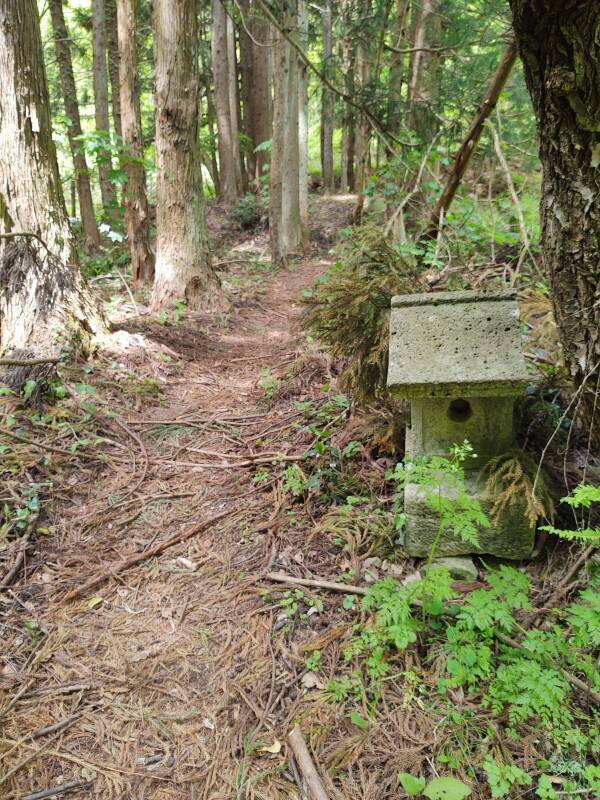

Gorintō Caves
A gorintō is a five-level stone tower, a Japanese form of pagoda. It's a common design for a Buddhist grave marker or memorial. Caves along the trail just north of the Jōmon and temple site have held many gorintō, and some still do. Some of these gorintō have dates carved into them going back to the Kamakura period of 1185–1333.


The segments of a gorintō represent the five elements of Buddhist cosmology. They are thought to form the body of the cosmic Buddha Mahāvairocana, our human bodies, and the physical world. The five elements plus wisdom make up the universe. They are typically marked with the Sanskrit Siddhaṃ script. From top to bottom they are:
| Shape | Represents | Siddhaṃ | Japanese |
| Jewel-shape | Ether | 𑖏 / kha | kuurin |
| Hemisphere | Air | 𑖮 / ha | fuurin |
| Pyramid | Fire | 𑖣 / fa | karin |
| Sphere | Water | 𑖪 / va | suirin |
| Cube | Earth | 𑖀 / a | chirin |
The top two elements, the hemisphere representing Air and the jewel-shape representing Ether or Space, are usually merged. Sometimes they aren't clearly distinguished from the top of the pyramid representing Fire.
Shugendō Training Ground
The trail winds around and leads upward to another open clearing. It is surrounded on three sides with rock faces, and a sign marks it as Shugenjo Site and the Bishamonten Cliff.
Visiting Mount Haguro, a Shugendō Holy MountainThis was a training ground for the Shugendō faith, a blending of Buddhism, Shintō, and pre-Shintō beliefs. Shugendō involves ascetic practices carried out on mountains.
The Bishamonten rock face is directly across as you arrive at the site. This open area was where the Shugendō ascetics meditated, studied, and carried out esoteric practices.

A signboard here says, according to Google Translate for images, that it was said to resemble a folding screen.

Looking to the right, we're expected to perceive a male rock or lingam sliding into a female rock face or yōni. Google is very quick to flag a page as objectionable, so I'm going with the Sanskrit terms.

It doesn't look very lurid.

I was ready to continue along the path from the Shugendō training ground, but I would have to squeeze between these large stones. They're a second yoni–lingam pair.
That's the Otoko-iwa or the lingam rock on the right, the Onna-iwa or the yoni rock on the left, and the Tainai-kuguri or the birth canal opening between them.

Yoni or योनि on the left, lingam or लिड्ग on the right, birth canal straight ahead. Everything is green with ferns and moss and lichen.

Looking up the yoni.

Down out of the birth canal and onto the path.

Shiro-iwa Nana-iwa
The path curved along a ridge line. This was Shiro-iwa Nana-iwa, named for being a series of seven stone outcroppings.
Seven, of course, the usual mystic number, like the number of days in the week and the number of hills in prominent cities. It all comes from the seven moving visible bodies in the sky — Sun, Moon, and the planets Mercury, Venus, Mars, Jupiter, and Saturn.

The seven rocks are Yumihari-iwa, Tate-iwa, Saru-iwa, Kagami-iwa, Shio-iwa, Toride-iwa, and Ko-iwa. The local legend is that from the Tokorobu commune on the opposite side of the valley they look like the outer wall of a shiro or castle, hence "Shiro-iwa". It looks like a medieval castle or a hidden fortress.
This is your periodic reminder that George Lucas's original Star Wars movie was based on Akira Kurosawa's The Hidden Fortress and Lucas had wanted Toshiro Mifune to play Obi-wan Kenobi.
Pondering the missed opportunities for vast cinematic improvements, I continued along the path.

I came to the first outcropping with a clear view out across the valley.

Wow, what a view!

Back up onto the trail, just a little further along it, then down onto the next outcropping.


Looking down to the east, you can see the road out of Yamadera town running away from the viewpoint. It ends just past that last group of buildings. You can also see the rail line. It continues through the central pass, entering the first of several long tunnels on its way to Sendai on the Pacific coast.


The next outcropping offers different views. First, looking straight out to the east.

Second, turning to the left to look northeast.

Then, a little south of east.

Finally, turning to the right to look to the southeast, almost south.

Continuing beyond the seven rock outcroppings, the path passed between some unusual rock formations.
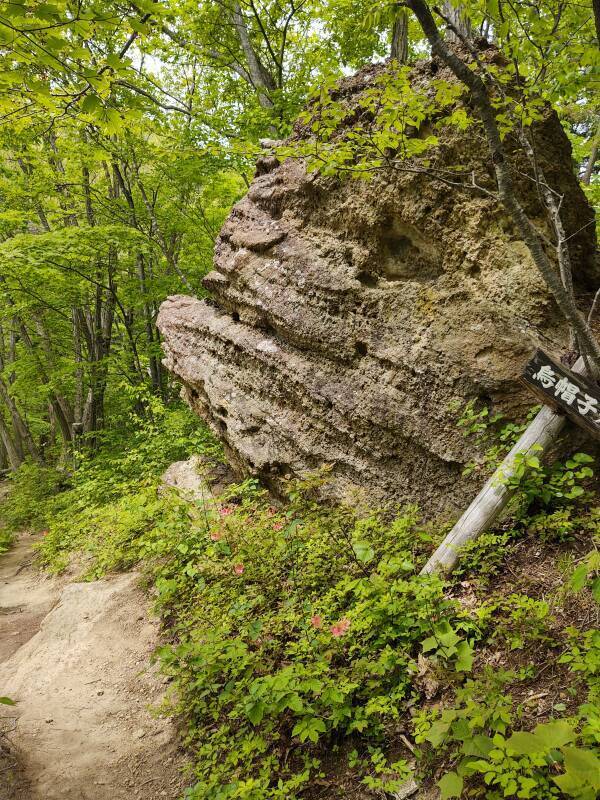
Tarumizu Ruins
The path descended some as it led into the Tarumizu ruins.
The syncretic religion of Shugendō formed in Japan during the period 710–794, after Empress Genmei had established a capital at Heijō-kyō, today's Nara, and before Emperor Kammu moved the Imperial Court to Heian-kyō, today's Kyōto. It combines elements of the native Japanese Shintō, esoteric Buddhism as it was arriving from China, Taoism, and local shamanistic folk religions.
Shugendō practitioners are ascetic hermits. They're called Yamabushi, a name referring to how they prostrate themselves on mountains.
Caves here became shrines for the various religions and hermitages for their practitioners, shifting in focus over the centuries from when Ennin founded the nearby Risshaku-ji temple in 860 CE through the Meiji Period of 1868–1912.


F. Victor Dickens, 1906
Yamabito is a term from Japanese folklore. It refers to a group of people who, according to folklore and a few modern-day academics, are cultural holdovers from the pre-Yamato Jōmon period from thousands of years ago.
Believers say that the yamabito were descendants of an early race of people who were forced up into the mountains as the Yamato people spread northeast through Honshū and largely settled in the lowlands.
Yamabito legends are said to be the origin of the concept of being "spirited away" as depicted in the 2001 Studio Ghibli movie, which is filled with Shintō imagery. The "spirited away" concept is known as kamikakushi or being "hidden by kami", the Shintō deities or spirits.
There was a harsh academic argument in the 1910s as to whether the yamabito actually existed. Regardless of whether the Yamabito ever existed or not, the Yamabushi ascetic hermits and their Shugendō faith definitely exist.
The Emperor returned to power with the Meiji Restoration of 1868. The Emperor was extremely pro-Shintō because Shintō teaches that the Emperor is directly descended from the gods. Buddhism and Shintō had become blended through the centuries. The program to re-separate them started in 1868, with Buddhism being suppressed when there was any conflict. Shugendō was suppressed even more heavily, especially during the 1912–1926 reign of Emperor Taishō.
The religious activity here had been continuing for over a millennium, but it came to an abrupt end in the early 20th century.
The relationship between Shintō and the Japanese state was terminated with the end of World War II. Freedom of religion was established, and Shugendō began rebuilding.
The stone in these bluffs contains pockets of sodium sulfate and sodium chloride which are dissolved by water. The result looks somewhat like bread.


The Furumine Shintō shrine is once again being maintained. I climbed up to that second torii which was freshly repainted in bright vermilion.





Both the newer and the lower, older torii had the Shintō shimenawa rice straw or hemp rope. Shimenawa, sometimes with shide or zig-zag paper streamers, are believed to repel evil spirits and protect a sacred space.


Once through the lower torii I could better see the upper one and the shrine.
The vermilion torii at Shintō shrines are like doorways and gates at Buddhist temples, Judaism's Holy Temple in Jerusalem, Christian churches, and Islamic mosques — each one marks a passage into increasingly sacred space.



The Kitsune fox figures indicate that this is almost certainly an Inari shrine.

The kami Inari is associated with harvests, foxes, and general prosperity. Worship of Inari began in the 9th century CE, Inari is the most popular of the Shintō kami. Out of the roughly 80,000 or more Shintō shrines, at least 32,000 are dedicated to Inari.
Kitsune are foxes with paranormal abilities who serve as Inari guardian figures and messengers. Veneration of foxes goes back to the Jōmon period when fox teeth and jawbones were used to create necklaces.
The high-altitude mountaineer Ed Viesturs is the only American to have climbed all fourteen of the world's 8,000-foot mountains, and was the fifth person to do so without using supplemental oxygen. He is famous for having written, "Getting to the top is optional. Getting down is mandatory."
Be like Ed. Don't go up anything unless you're certain that you can safely descend. Going down is always harder than going up.



Safely back down on the main trail, you can see another shrine to your right. It's based around a vertical crevice formed over the centuries as a small spring cut through the soft tuff. It is a mixed Buddhist and Shintō shrine, and undoubtedly had aspects of Shugendō mixed in before the Meiji Emperor's drive to "purify" Shintō and emphasize its divinity of the Emperor.
This is where the founding priest Ennin is believed to have stayed while studying and meditating in the 9th century CE.


Some Shintō shrines are dedicated not to a deity but instead to an aspect of nature — the view from a certain spot or the sound of falling water. The trickling spring water and the unusual rock shape are the devotional focus here. The brass rattles and hanging ropes at the base are Shintō additions, used to awaken the kami or deity.


When you get closer, you can see that there's a small statue of a Buddhist deity on a high ledge inside the crevice, and another at the bottom of the crevice.


The Buddhist deity was originally known in Sanskrit as अचल or Acala, "The Immovable".
Or, as अचलनाथ or Acalanātha, "Immovable Lord".
Or, as आयचिलनाथ or Āryācalanātha, "Noble Immovable Lord".
Japanese Buddhism simplifies this by using the name Fudō Myōō, the Immovable Wisdom King. He's a wrathful deity and protector of the Dharma, a remover of obstacles and destroyer of evil.
You can see a knee-high statue of Fudō Myōō on a ledge about half-way up the crevice. There's another at the bottom of the crevice.
You can see green moss sustained by water dripping down through the crevice. Both lay people and ordained monks following Yamabushi mountain ascetic traditions of Shugendō would often take small statues of Fudō Myōō into the mountains for devotions. They would often place these statues near waterfalls or in caves. This location provided a combination of the traditional settings.
The origins of Minenoura as a religious center go back at least to Ennin's founding of Risshaku-ji in the 9th century CE. It may have already been a center for meditation and other practices when Ennin arrived, that may have been why he selected the location. Minenoura was active until the early 20th century, when the Meiji Restoration had led to state-linked Shintō and the cult of the Emperor. This area was suddenly and completely shut down.
I continued along the path, down the hill toward Senjuin Kannon-dō, the Buddhist temple by the road and rail line.

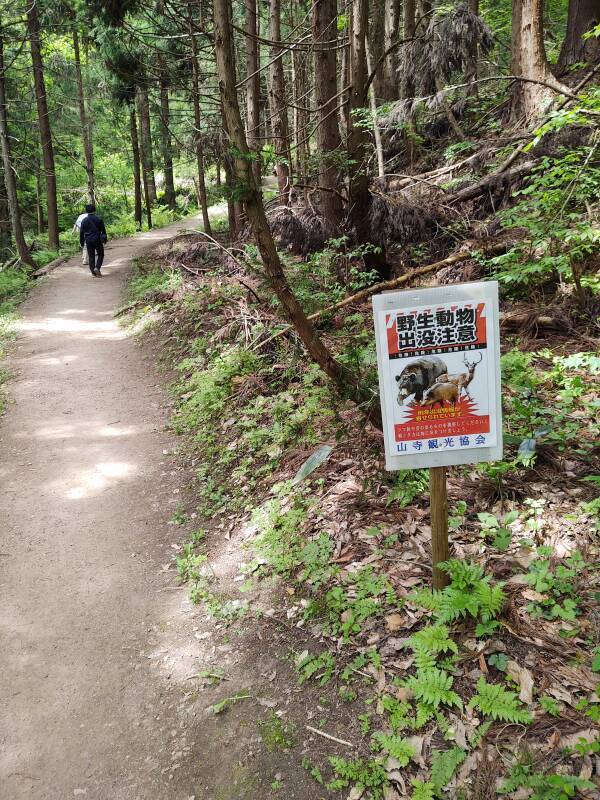
I saw a sign along the path, facing toward people coming up the slope and entering the area. I turned to see what it was about. It warned of possibly dangerous animals in the area. I had seen signs about monkeys and bears at the other end of the trail, just past the cemetery. But wait, there's more!
An estimated 10,000 Japanese black bears or Ursus thibetanus japonicus, a subspecies of the Asian black bear, live in Japan. They're not nearly as large as the Kamchatka brown bears found to the north on that peninsula and some islands, which in turn are far more mellow than the East Siberian brown bears. But still, don't mess with the local bears.
The Japanese boar lives throughout all of Japan other than Hokkaido in the far north and the Ryūkyū Islands that stretch from south of Kyūshū to Taiwan. It's a prominent figure in Japanese folklore, famed for being fearless and reckless. "As reckless as a wild pig" is a common Japanese metaphor.
The sika deer was once common throughout eastern Asia, from northern Vietnam north through the Russian Far east. Now it's rarely spotted in much of its historic range, except for Japan where it has become overabundant. The Japanese wolf was the main predator of the sika deer. The wolf became extinct and the deer population exploded.
How dangerous could deer be? They're bold to the point of belligerence. They swarm part of the city of Nara, where they're revered as messengers of the Shintō deities. Signs warn you not to bow to them, as they interpret that as an invitation to a head-butting contest.
There are plenty of hazardous animals to watch for, and this sign doesn't even mention the monkeys.
The Japanese macaque is sometimes referred to as the "snow monkey", largely because of tourism promotions showing them in hot springs surrounded by snow. They are relatively cold-tolerant, some of them live in areas snow-covered for months each winter. No other non-human primates live as far from the equator. However, they aren't native to Hokkaido, the northernmost of the four main islands. Even purported "snow monkeys" have their limits.

The Japanese wolf or Canis lupus hodophilax was the last surviving wild member of the Pleistocene wolf lineage. Its skeletal remains have been found at Jōmon settlements, the earliest human settlements in Japan, and it probably followed the same overland route the humans took south into today's Japan during the last ice age.
The Japanese wolf was always portrayed favorably, as a divine messenger who also protected crops from deer and swine. Many shrines deify the wolf, invoking it to ward off evil and misfortunes. Wolves feature in Princess Mononoke, Wolf Children, and other popular anime.
Rabies appeared among dogs in Japan in the mid 1730s, and rapidly spread throughout the country. The disease reached wolves and turned some into vicious man-killers, leading to large-scale wolf hunts. After the Meiji Restoration opened Japan to western traders, fatal canine distemper virus spread from western dogs to the dogs and wolves of Japan.
New government policies established after the Meiji Restoration led to the wolves being completely exterminated. The last known Japanese wolf was captured and killed in Nara Prefecture in January 1905. Occasional sightings of what are claimed to be remnant wolves are still reported, but for the most part they're thought to be mistaken. See the December 2020 article in Cell for details.
The Japan Wolf Organization [English version here] hopes to re-introduce wolves to Japan. Wolves could curb the overabundance of deer and boars. And, one would hope, get those nasty monkeys under control.
Senjuin Kannon-dō Temple
I continued down the slope, unmolested by wildlife. The trail came out of the forest at Senjuin Kannon-dō and an attached cemetery. The –dō means that this is a Buddhist temple.



The Mahāyāna bodhisattva अवलोकितेश्वर or Avalokiteśvara is known in China as Guānyīn and in Japan as Kannon. The Lotus Sutra states that Kannon manifests in 33 different forms to alleviate the suffering of all living beings.
And so, Senjuin Kannon-dō is a temple which enshrines an image of Senjuin Kannon, the thousand-armed form of Kannon. This temple is the second stop on a local pilgrimage route visiting 33 temples, one per manifestation of Kannon.
Ofuda or paper talisman strips of various colors are tacked up inside. Pilgrims write prayers on these strips and hang them at the temples along the way. The colors indicate how many times the pilgrim has completed the circuit.
The temple end of the Minenoura trail has an all-threat collection of wildlife warnings. Sure, now they tell me.

Leaving the temple, you go down a staircase and then cross the rail line. Look both ways!


It was a fairly short walk along the road from that temple to Yamadera Station. Along the way I passed the Bo-nyoten or Senju Kannon monument mentioned at the beginning of the trail, up the slope above this.

Back in town, I needed to make a difficult decision. What flavor of ice cream?


I got another roasted sesame seed soft-serve cone.


Then a second one, this one made with matcha tea.
Continuing to Mount Haguro
My first visit to Yamadera was in 2023. On that trip, I traveled the next day to Mount Haguro, a Shugendō holy mountain and now a pilgrimage destination for both Shintō and Buddhism.
Other topics in Japan:
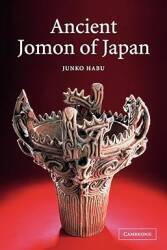





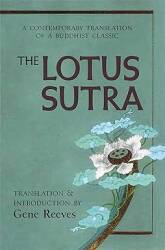





































Dharma or धर्म is a concept in multiple Indian religions. In Buddhism it refers to the teachings of the Buddha.